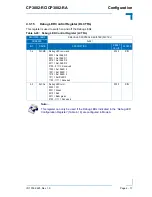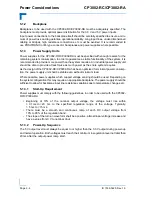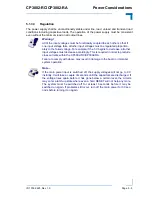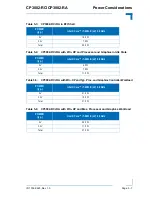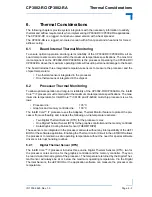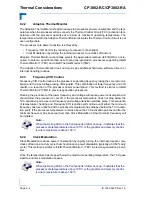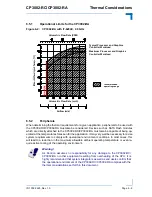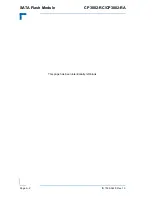
Thermal Considerations
CP3002-RC/CP3002-RA
Page 6 - 4
ID 1039-3625, Rev. 1.0
P R E L I M I N A R Y
6.2.2
Adaptive Thermal Monitor
The Adaptive Thermal Monitor feature reduces the processor power consumption and the tem-
perature when the processor silicon exceeds the Thermal Control Circuit (TCC) activation tem-
perature until the processor operates at or below its maximum operating temperature. The
temperature at which the Adaptive Thermal Monitor activates the Thermal Control Circuit is not
user-configurable.
The processor core power reduction is achieved by:
•
Frequency/VID Control (by reducing of processor core voltage)
•
Clock Modulation (by turning the internal processor core clocks off and on)
Adaptive Thermal Monitor dynamically selects the appropriate method. uEFI BIOS is not re-
quired to select a specific method as with previous-generation processors supporting Intel®
Thermal Monitor 1 (TM1) and Intel® Thermal Monitor 2 (TM2).
The Adaptive Thermal Monitor does not require any additional hardware, software drivers, or
interrupt handling routines.
6.2.3
Frequency/VID Control
Frequency/VID Control reduces the processor’s operating frequency (using the core ratio mul-
tiplier) and the input voltage (using VID signals). This combination of lower frequency and VID
results in a reduction of the processor power consumption. This method is similar to Intel®
Thermal Monitor 2 (TM2) in previous generation processors.
Running the processor at the lower frequency and voltage will reduce power consumption and
should allow the processor to cool off. If the processor temperature does not drop below the
TCC activation point, a second frequency and voltage transition will take place. This sequence
of temperature checking and Frequency/VID reduction will continue until either the minimum
frequency has been reached of the processor temperature has dropped below the TCC activa-
tion point. If the processor temperature remains above the TCC activation point even after the
minimum frequency has been reached, then Clock Modulation at that minimum frequency will
be initiated.
6.2.4
Clock Modulation
Clock Modulation reduces power consumption by rapidly turning the internal processor core
clocks off and on at a duty cycle that should reduce power dissipation (typically a 30-50% duty
cycle). This method is similar to Intel® Thermal Monitor 1 (TM1) in previous generation proces-
sors.
Once the temperature has dropped below the maximum operating temperature, the TCC goes
inactive and clock modulation ceases.
Note ...
When the Debug LED on the front panel is lit after boot-up, it indicates that the
processor die temperature is above 105°C or the graphics and memory control-
ler die temperature is above 100°C.
Note ...
When the Debug LED on the front panel is lit after boot-up, it indicates that the
processor die temperature is above 105°C or the graphics and memory control-
ler die temperature is above 100°C.


